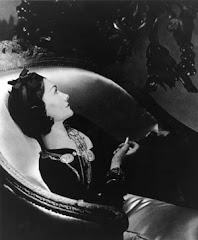This is my piece from the Telegraph about Lucien Lelong, who stood up to the occupying German forces and saved Paris from being moved to Berlin:
Paris struggled on, but when war was declared on 3 September 1939 the couture houses closed down, some for ever. Mainbocher and Schiaparelli left for America. Vionnet never reopened. Lelong was now president of the Chambre Syndicale de la Haute Couture and, after the invasion, it was his job to negotiate with the occupying German regime. The Nazis wanted to move Paris lock, stock and barrel to Berlin by any means, including violence. On 20 July 1940 five Nazi officers arrived at the headquarters of the Chambre Syndicale on an 'inspection'; five days later they broke into the building and requisitioned the archive.
Under the Nazi plan the Paris ateliers would be moved to Germany or Austria, where they would train a new generation of German dressmakers. The designers would also be moved. Within a generation, the Nazis expected, couture would be German, not French. It was a breathtakingly arrogant ambition to believe that they could appropriate a whole industry.
Lelong pointed out that the plan was unworkable. French fashion was dependent on thousands of skilled artisans in tiny ateliers, each specialising in one small detail of finish, such as embroidery. The skills, he explained, were unteachable. You could not transfer them, and it took decades to reach the necessary levels of craftsmanship. The intransigence of the Germans was nothing compared with that of French couture. Lelong asserted the right of each country to produce its own fashion and argued that it was their home environment that allowed the workers to do what they did. The Nazis backed down and returned the archive, and Lelong negotiated to keep a supply of fabric that would maintain production. The only fall-back the occupiers had was to conscript into the army its labour force. They started by demanding 80 per cent; Lelong got it down to five per cent.
Initially, after the liberation, there were murmurs that Lelong had been a collaborator, though it was Chanel who had spent the war living with a German officer. His case came to trial, but he was acquitted. The judge ruled that Lelong had co-operated only minimally with the Nazis to save France's cultural heritage and the jobs of its workers.

